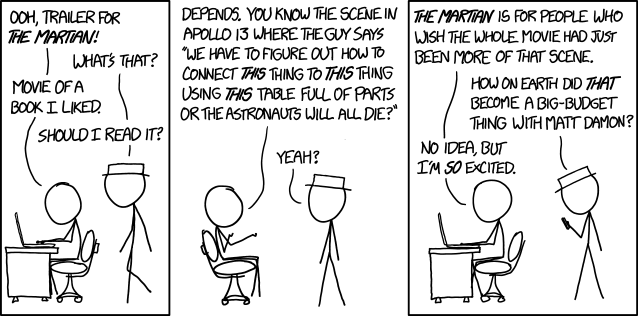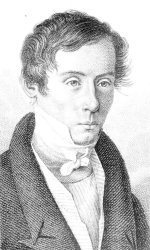Published in early 2014, it is a book written by a programmer, Andy Weir, and it is his first book. As any first book, and as any book written by someone whose day job is not being a writer, it’s not perfect. The style is so so, and sometimes even poor. But it is good enough. It is written with an engineer’s attention to technical detail though, and that makes reading a very fun experience for technical people, even if at moments it gets long and hard to follow.
The story is fairly well exposed by the trailer of the upcoming Matt Damon starring blockbuster movie: in a near future, a Mars exploration mission is aborted and the crew leaves the base, leaving one dead crew member behind. Except he’s not dead, and as he wakes up, he realizes he’s alone, without means of communication, forsaken on a lifeless planet, with a month worth of food, and about four years until a potential rescue mission reaches him.
From there, the author tells the story of how his character tries to survive with what he has at hand, while maliciously throwing at him all sorts of traps, accidents and set backs: “haha, today while working you create a short circuit and kill an essential piece of circuit”. It is all story told with care for realism that turns some parts into challenging puzzles (wait, you just killed him there! How can he make it out of that? Oh, nice, that’s clever! – or on the contrary – Ha! I know, he can use this and that, haha, I’m so smart) and includes some parts that rank pretty well on the adventure scale, like when he decides he’s gonna fetch an exploration rover 800km away to use its communication system.
Most of the book is narrated as logbook entries on the Mars side, and from a spectator’s point of view on the NASA side. It makes the reader aware of both sides while appreciating how each side tries to understand and anticipate what the other is doing. So this narration works very well for suspense.

xkcd alt text: “I have never seen a work of fiction so perfectly capture the out-of-nowhere shock of discovering that you’ve just bricked something important because you didn’t pay enough attention to a loose wire.”
Funny coincidence: at the time of writing I didn’t realize I chose the exact same example as the xkcd alt text.
But on the down side, as I was saying, there are weaknesses in style. Essentially, I’d say there are mainly two of them. One is the fact that most of the story is told by shiplog entries, and those entries contain details to serve exposition that would never be logged in real life, like an astronaut explaining how the base works. The other one is the tone of the book, upbeat, casual and funny, conveyed by the tone of the character’s log entries and meant to show his personality in the face of adversity and dire situations. This would be all good if it didn’t prevent log entries from being on par with the strictness and ethics one would expect from an engineer sent to Mars. But of course, that would also make the book reading a much more dry experience, so the author’s choice is understandable.
As a conclusion, I recommend this book, I had a lot of fun reading it and learned a couple of things about practical space exploration along the way which is pretty cool for a novel.
In this 45mn talk, the author Andy Weir presents the book, reads the first chapter, then present a tool he wrote to compute the trajectory of the ship:

